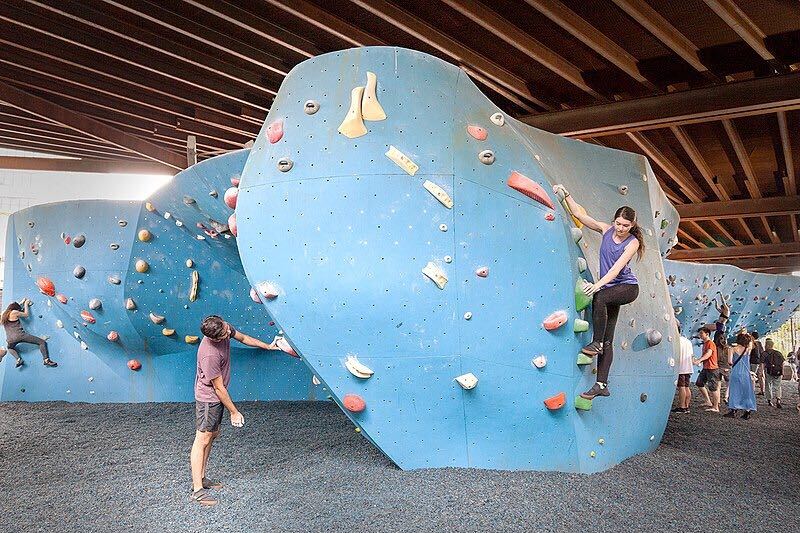
It’s fall in the Hudson Valley, which means the deli where I work is bustling with customers. Lots of familiar faces walk through the door, trying to make the most of what warm days we have left in the year. Others are totally tourists. Dressed in Patagonia gear from head to toe, they look like LEGO characters in their bold, primary-colored hats and jackets. New Paltz blooms at a time when most vegetation withers. Apple picking and hiking are some of the common responses I’m given when I ask what they plan to do in the area. But some, carrying curved shoes and chalk bags, have another goal: bouldering.
I’ve been bouldering on and off over the past year or so, but the climbers and weather have inspired me to get back in touch with the sport that’s so easy to cling to. In this article you’ll get an overview of what bouldering is and why you should get involved. I’ll be covering what equipment you’ll need and where you can go to do some bouldering of your own.
I’ve also enlisted the aid of avid climber Jonah Koen, a boulderer of over four years, to provide depth into the sport and the nitty gritty particulars. Here is Koen’s explanation for why fall is so popular for climbers: “Colder weather brings more friction on the rock. When the rubber [on your shoes] is in a colder temperature and you warm it up it sticks more to a colder surface… If it’s a dry and cold day, that’s kind of the ideal situation [for climbing].”
What is Bouldering?
Bouldering is a division of climbing, one in which your climb depends solely on your body, with no ropes or harnesses to help you along. You need to rely on your hands, arms, legs, and feet to maneuver in the best way possible up the boulder, which is how the sport got its name. Typically, routes don’t go higher than 20 or 30 feet. This means the sport is more of a sprint than a marathon, especially when compared to climbing..
“That’s one way to put it,” said Koen “It’s usually harder, more intense moves for a shorter period of time.”
Different bouldering routes are known as “problems” because the sport is as much mental as it is physical. When you aren’t actively climbing the wall, you’ll have to visualize the climb in your head, running different scenarios that might help you reach the top.
Why Should I Get Into Bouldering?
Firstly, it incorporates intense strength training, and substitutes for what a boring routine of lifting things up and putting them down in a gym. Here, the thing you’re lifting up is yourself, and the goal is to not “put yourself down” until you’ve reached the top of the wall. Hitting the wall builds muscles in your lats, arms, and core, so it covers a range of different exercises.
On that note, bouldering both inside and outside is considerably more engaging than a gym. The interior of a climbing gym has people clinging to all manner of walls at all different angles, which makes a very engaging visual, and you can’t beat the great outdoors for fresh air while you climb.
It’s a Team Effort!
More than the physical benefits, though, bouldering, and climbing by extension, are great ways to get out and meet new people. There’s a community built around helping others solve problems, with each person having a new vision for you on how to complete one. It can be intimidating at first, sitting back and watching more experienced climbers, but you’ll find that almost all of them are willing to give tips and pointers as to how they managed to work out a solution. Typically only one climber will be on any given portion of the rock, so it gives you and other climbers waiting their turn ample time to chat, share advice and get to know each other. Don’t get discouraged if you can’t follow the experts, though. Bouldering uses the V Scale to measure how difficult a climb might be for any given person. V0 is considered the easiest level to climb, most suited for beginners like yourself. V16 climbs are the hardest, and require expert maneuvering and grip. The higher the number, the steeper the incline, the smaller the hold.
My advice? Stick to the lower numbers for now.
What Will I Need to Get Started?
Part of what makes bouldering an easy entry into rock climbing for most people is the fact that equipment is minimal. There are three basic items you need to get into rock climbing, reduced down to two when climbing in a gym.
#1 – Climbing Shoes
Climbing shoes are downturned pieces of footwear meant to make it easier to hang on to footholds. They’re made out of a specialized rubber, grippier than a sneaker, which provides a sticky surface to cling on to either rock or the climbing holds in a gym. Since climbing shoes stretch, you should size down when getting a pair of your own; they’ll conform to your foot over about a month or so of break-in time, enabling you to reach more precise points. This comes in handy when trying to keep friction on the rock face, because of just how small some holds can get . Most of the pressure is directed into the big toe, according to Koen, so pushing down with your feet will make for a more precise and accurate hold.
Climbing shoes can get really specialized, and that’s why they have a wide price range. They can come as low as $30 in some cases, or cost as much as $220. You’re likely to get a better grip with newer, more expensive shoes, but buying secondhand is fine when learning the basics. Only once you’re hooked should you try to get a new pair, because they don’t come cheap. Koen’s imported Italian climbing shoes – he climbs in the Alps – cost him roughly $180.
#2 – Chalk & Chalk Bag
Chalk is used by a variety of athletes in different sports, and it’s relatively common to see power lifters and people in the gym using it to keep their hands dry, thereby providing better grip. You can imagine how important this is in climbing, a sport that’s all hands-on. Chalk bags serve as receptacles for said chalk, and you can wear them to keep your hands sweat-free during a longer route. A block of chalk can go for roughly $3, and a chalk bag for as low as $10 from a secondhand climbing store like Rock & Snow’s Annex.
#3 – Crash Pad
A crash pad is essential for bouldering outdoors. If you don’t have one, the only place to land is the bare ground, and falling onto tough earth from an altitude of 20 to 30 feet is dangerous, to say the least. A crash pad is made from a high-density foam pad that absorbs the impact of a fall when you land on them. It also functions as a backpack, and can hold the rest of your climbing gear while making your way to your spot. They can run anywhere from $100 to $200, depending on the brand you go with. Koen bought his crash pad secondhand, and hasn’t had any problems. “If it’s in good condition and hasn’t been used for more than a couple of years, then it’s good to buy and keep the stream of recycling going.”
Where Can I Go Bouldering?
I, as a relative newbie to climbing, have only ever kept my sessions within the confines of BC’s Climbing Gym, the spot for most locals to brush up on their skills when they aren’t in the Gunks –that’s the Shawangunk Mountains, that ridgeline that you can see from campus. If you’re not ready to buy your own set of equipment, the gym offers rentals of all the equipment you could need.
Koen recommends starting indoors. It’s a way more accessible starting point because the gym itself is one big foam mat. That makes it so you can land anywhere without being too worried for your safety.
When it comes to heading outdoors, this is one of the most accessible and bountiful areas of rock climbing in the entire East Coast region of the United States. Twenty minutes outside of town are beautiful rock faces with bouldering opportunities for beginners and experts alike. Koen recommends the carriage road in the West Trapps. The boulders lined along the rock face make it easy to set your pads up and climb. The trailhead parking lot gets packed quickly on the weekends, so you should plan to get there early. Better yet, go on a weekday, while the city kids are buckled down in their boroughs.
Ben Cherry, an employee at BC’s, also recommends climbing at Peterskill, a 10-minute drive from the West Trapps parking lot. According to him, it’s a densely packed area full of easier climbs, perfect for the beginner boulderer. There’s a steeper learning curve for climbing outside though, he stresses. “The holds are smaller, it’s a little bit more painful, and it’s not perfectly molded like in a gym,” he says while displaying his callused hands.
The Mountain Project serves as a digital guidebook for routes both domestic and international, which makes it a priceless tool in finding gyms and climbing spots. The frequency of both regulars and tourists to these spots means there will likely be someone willing to point you in the right direction.
Cherry says the big bonus to living in the area is that these outdoor routes are far from busy on weekdays, so you can take your time to really practice and get comfortable without fear of hogging the space.
That’s roughly all the info you’ll need to know to get involved with bouldering. Don’t feel pressured to tackle harder problems because you see others doing it; I made that mistake and only ended up discouraged. Ask some of the more experienced boulderers around you what some good starter routes look like, and they’ll no doubt point you in the right direction.
See you on the rocks!
